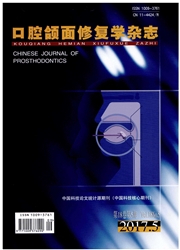

 中文摘要:
中文摘要:
目的:比较牙髓、牙周膜和脐带三种不同来源间充质干细胞的(Mesenchymal stem cells,MSCs)三系分化潜能。方法:培养分离人脐带间充质干细胞(Umbilical cord mesenchymal stem cells,UCMSCs)、牙髓干细胞(Dental pulp stem cells,DPSCs)和牙周膜干细胞(Per iodontal ligament stem cells,PDLSCs);倒置显微镜观察细胞形态,体外诱导这3种MSCs向成骨、成脂和成软骨方向分化,通过茜素红染色、油红O染色、阿尔辛蓝染色分别鉴定细胞成骨、成脂和成软骨分化能力,进一步实时荧光定量PCR检测比较3种细胞成骨相关基因OCN和RUNX2及成脂相关基因PPAR-γ的表达水平。结果:这3种MSCs细胞形态略有不同,三者均可向成骨、成脂和成软骨方向分化,但其分化潜能有所差异,DPSCs成骨和成脂向分化能力强,UCMSCs则更适于成脂和成软骨向分化,而PDLSCs成软骨向分化较具优势。结论:DPSCs,PDLSCs和UCMSCs三系分化潜能不同,本研究为干细胞临床转化中选择理想细胞来源提供实验依据。
 英文摘要:
英文摘要:
Objective: To isolate and identify human mesenchymal stem cells from umbilical cord, dental pulp and periodontal ligament(h UCMSC, h DPSC and h PDLSC) and to compare the differentiation potentials of MSCs from the three sources, in order to provide further evidence for MSCs application. Methods: The three type of MSCs were isolated by using explant or enzymatic methods, compared for cell morphology and tri-lineage differentiation potential by using inverted microscope, specifically staining and real-time polymerase chain reaction(RT-PCR), respectively. Results: Cell morphology of h UCMSCs, h DPSCs and h PDLSCs were slightly different, compared with h UCMSCs, h DPSCs and h PDLSCs showed more elongated morphology. The three cell types were differentiated into osteocytes, adipocytes and chondrocytes, but with a difference in differentiation potentials that the osteogenic and adipogenic differentiation potentials of h DPSC were significantly enhanced compared to h UCMSC and h PDLSCs; In contrast, h UCMSC was more able to differentiate into adipogenic and chondrogenic lineage; and h PDLSCs appeared was less able to differentiate into osteogenic and adipogenic lineage, although h PDLSCs have an advantage in chondrogenic differentiation. Conclusions: MSCs from dental pulp, periodontal ligament and umbilical cord possess different differentiation potentials. This study provides an important reference for choice ideal MSCs type in clinical application.
 同期刊论文项目
同期刊论文项目
 同项目期刊论文
同项目期刊论文
 Gene-Modified Stem Cells Combined with Rapid Prototyping Techniques: A Novel Strategy for Periodonta
Gene-Modified Stem Cells Combined with Rapid Prototyping Techniques: A Novel Strategy for Periodonta 期刊信息
期刊信息
